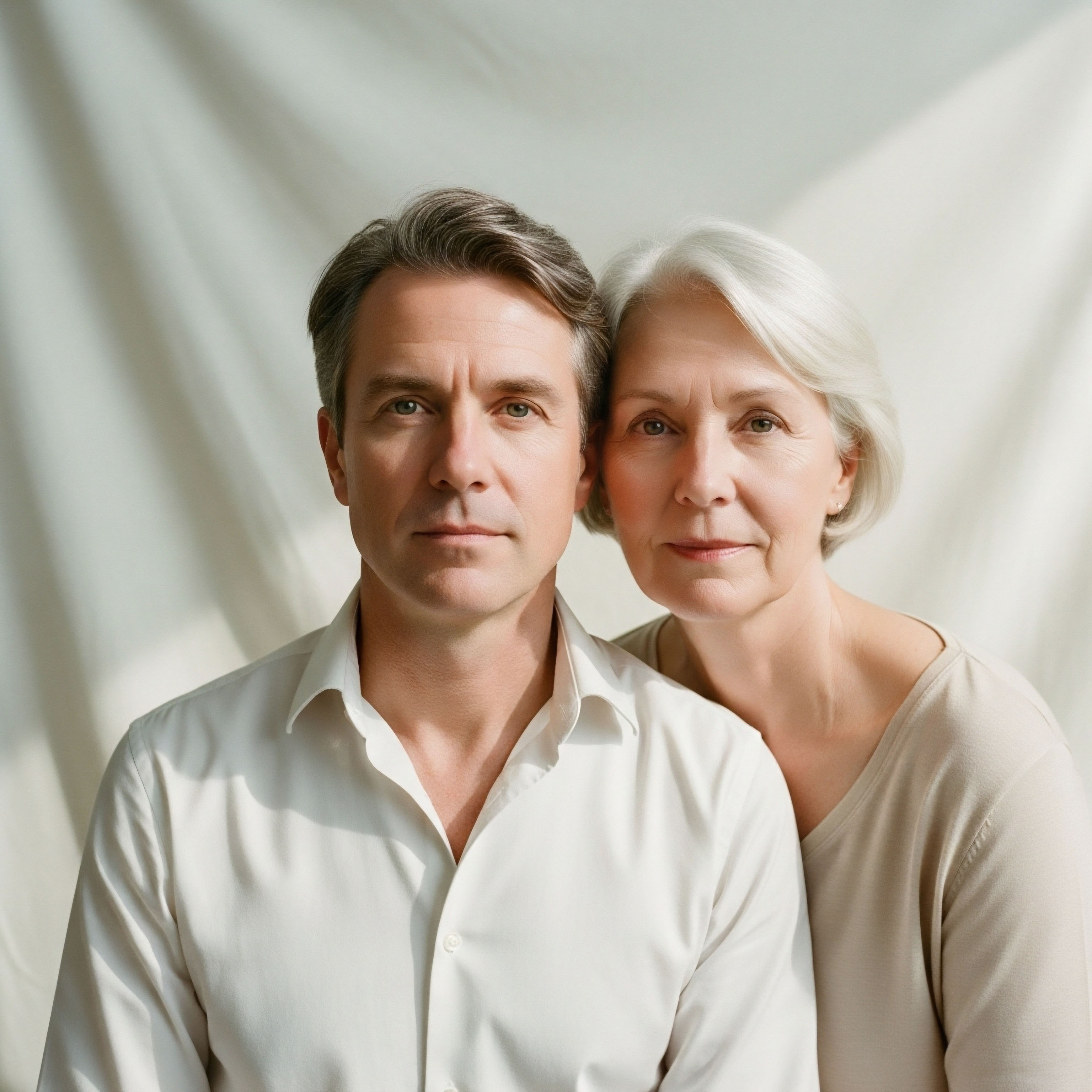

Fundamentals
You may be here because you feel a shift within your own body. Perhaps it’s a subtle but persistent fatigue, a change in mood that you can’t quite attribute to daily stress, or a noticeable difference in your physical performance and recovery.
These experiences are valid, and they often point toward the intricate communication network of your endocrine system. One of the most important conversations happening within that network is the one between testosterone and estradiol. Your vitality is deeply connected to the balance of these two hormones. Understanding how your daily choices, specifically what you eat and how you move, directly influence this balance is the first step toward reclaiming command of your own biological systems.
Estradiol is a form of estrogen. In the male body, it is a potent and necessary hormone, synthesized directly from testosterone. This conversion is facilitated by an enzyme called aromatase. Think of aromatase as a biological gatekeeper, deciding how much of your testosterone pool is transformed into estradiol.
This process is essential. Estradiol in men contributes to maintaining bone density, supporting cognitive function, and modulating libido. A healthy male physiology depends on having the right amount of estradiol available. The key lies in the ratio of testosterone to estradiol, a delicate equilibrium that dictates much of how you feel and function.

Where Hormonal Conversion Occurs
The activity of the aromatase enzyme is not uniform throughout your body. Its primary site of action in men is adipose tissue, more commonly known as body fat. This biological fact is the central pillar in understanding how lifestyle impacts your estradiol levels.
The more adipose tissue you carry, the more aromatase enzymes are present and active. A higher concentration of this enzyme creates a scenario where a greater proportion of your testosterone is continuously converted into estradiol. This directly alters your testosterone-to-estradiol ratio, which can lead to the very symptoms that may have brought you here seeking answers. Therefore, managing your body composition is the most direct way to manage this conversion process.
Managing estradiol levels in men begins with understanding that body fat is the primary site of testosterone-to-estradiol conversion.
Lifestyle factors like diet and exercise become profoundly important because they are the most effective tools for influencing body composition. Your daily nutritional choices and physical activity patterns directly regulate the amount of adipose tissue you have. By extension, these choices regulate your body’s total aromatase activity and, consequently, your estradiol production.
This is a system of interconnected signals. Your actions create a biological response that echoes through your entire hormonal axis, starting with the very composition of your physical body.

What Is the Role of the Hypothalamic Pituitary Gonadal Axis?
Your body has an intelligent control system for hormone production called the Hypothalamic-Pituitary-Gonadal (HPG) axis. The hypothalamus in your brain monitors hormone levels in the blood. When it detects a need for more testosterone, it signals the pituitary gland, which in turn signals the testes to produce it.
This system also responds to estradiol. If estradiol levels become too high, the hypothalamus reads this as a signal that the system is saturated. It then slows down its signals to the pituitary, which reduces the entire cascade of testosterone production. This is a protective feedback loop.
In a state of elevated estradiol driven by excess body fat, this feedback loop can inadvertently suppress your natural testosterone production, creating a challenging cycle where high estrogen and low testosterone reinforce each other.
This is why understanding your own body is so empowering. The symptoms of hormonal imbalance are not a personal failing; they are the logical outcome of a biological system responding to its environment. By learning to modify that environment through deliberate lifestyle choices, you can begin to guide your physiology back toward its optimal state of function and vitality.


Intermediate
Moving beyond foundational concepts, we can examine the specific, actionable protocols within diet and exercise that allow you to modulate your hormonal environment. The goal is to create a systemic shift that favors lean mass over fat mass, enhances insulin sensitivity, and provides the raw materials for optimal endocrine function.
This involves a more nuanced look at not just calories, but the quality of your food and the type of physical stressors you apply through training. Your body is an adaptive machine, and providing the right stimuli will guide its adaptation toward a healthier hormonal profile.

Strategic Dietary Interventions
The primary dietary lever for reducing estradiol is managing body fat. A consistent caloric deficit is the most reliable method for reducing adipose tissue. This requires consuming fewer calories than your body expends. Once this principle is in place, the composition of your diet can provide additional benefits.
A diet rich in fiber and specific micronutrients can support healthy estrogen metabolism and detoxification pathways. Foods from the cruciferous vegetable family, such as broccoli, cauliflower, and kale, contain compounds like indole-3-carbinol, which assists the liver in processing estrogen metabolites. Similarly, certain foods are thought to have a mild aromatase-inhibiting effect.
These include shiitake and portobello mushrooms, as well as compounds like resveratrol found in the skin of red grapes. While these foods are not a replacement for sound body composition management, they can be a valuable part of a comprehensive strategy.
A diet focused on a caloric deficit, high fiber intake, and nutrient-dense whole foods provides the ideal foundation for managing estradiol.

Addressing Phytoestrogens and Alcohol
A common point of confusion is the role of phytoestrogens, particularly those found in soy products. Phytoestrogens are plant-derived compounds with a chemical structure similar to estrogen, allowing them to bind to estrogen receptors.
Extensive research, including multiple meta-analyses of clinical trials, has shown that consumption of soy or isoflavones does not have a significant effect on testosterone or estradiol levels in men. The fear of feminizing effects from moderate soy consumption is not supported by the weight of scientific evidence. Your focus is better placed on overall dietary patterns rather than the exclusion of specific plant foods.
Alcohol consumption, on the other hand, presents a more direct challenge to hormonal balance. Chronic or excessive alcohol intake can impair liver function, which is critical for breaking down and clearing estrogen from the body. It can also increase inflammation and contribute to fat storage, particularly visceral fat, further driving aromatase activity. Moderating alcohol intake is a key lifestyle modification for supporting a healthy testosterone-to-estradiol ratio.

Exercise Protocols for Hormonal Recalibration
Exercise influences your hormonal axis through several integrated mechanisms. It expends calories, builds metabolically active muscle tissue, and improves insulin sensitivity. A well-structured exercise program should incorporate both resistance training and cardiovascular work.
- Resistance Training ∞ Lifting weights is the most effective stimulus for building and maintaining muscle mass. An increase in muscle mass improves your overall body composition and raises your resting metabolic rate, making it easier to maintain a healthy body fat percentage. The improved insulin sensitivity from resistance training also helps mitigate the metabolic dysfunction that can drive up aromatase activity. Focus on compound movements like squats, deadlifts, presses, and rows that engage large muscle groups.
- Aerobic Exercise ∞ Steady-state and high-intensity interval training are both effective for burning calories and reducing body fat. Studies have shown that regular aerobic exercise can specifically decrease the circulating estradiol-to-testosterone ratio in overweight and obese men. This appears to be driven both by fat loss and by other metabolic improvements.
A balanced weekly routine might involve three to four days of resistance training and two to three days of cardiovascular exercise. This combination creates a powerful, synergistic effect, simultaneously reducing the body’s capacity to produce excess estradiol while enhancing the physiological environment that supports healthy testosterone levels.
| Modality | Primary Mechanism of Action | Effect on Body Composition | Direct Hormonal Impact |
|---|---|---|---|
| Resistance Training | Stimulates muscle protein synthesis, improves insulin sensitivity. | Increases lean muscle mass, reduces fat mass over time. | Improves testosterone-to-estradiol ratio indirectly by reducing aromatase substrate (fat). |
| Aerobic Exercise | Increases caloric expenditure, improves cardiovascular health. | Directly reduces body fat, especially when in a caloric deficit. | Shown to directly lower the estradiol/testosterone ratio in overweight men. |
| High-Intensity Interval Training (HIIT) | Maximizes caloric expenditure in a short time, significant metabolic impact. | Highly effective for fat loss and improving insulin sensitivity. | Potent stimulus for improving metabolic health, which underpins hormonal balance. |


Academic
A sophisticated analysis of estradiol regulation in men requires a systems-biology perspective, integrating endocrinology with metabolic science at the molecular level. The lifestyle-driven modulation of estradiol is not a simple input-output equation. It is the result of complex crosstalk between adipose tissue, the liver, the brain, and the gonads.
The central molecular player in this system is aromatase, the product of the CYP19A1 gene. Understanding the factors that regulate the expression of this gene is key to comprehending how diet and exercise exert their profound effects.

Adipose Tissue as an Endocrine Organ
In men, adipose tissue is the principal site of extragonadal estrogen production. The stromal cells within this tissue, including preadipocytes and macrophages, are rich in aromatase. In states of obesity, particularly with an accumulation of visceral adipose tissue, this tissue becomes dysfunctional.
It transitions into a state of chronic, low-grade inflammation, characterized by adipocyte hypertrophy, hypoxia, and infiltration of pro-inflammatory immune cells. These adipose-resident macrophages secrete cytokines such as tumor necrosis factor-alpha (TNF-α) and interleukin-6 (IL-6).
These inflammatory molecules act on the surrounding cells and have been shown to stimulate the tissue-specific promoter (I.4) of the CYP19A1 gene, leading to a significant upregulation of aromatase expression and activity. This creates a localized, self-perpetuating cycle where inflammation drives estrogen production, and the resulting hormonal milieu can further promote adipogenesis.
Chronic inflammation within adipose tissue directly upregulates the gene responsible for aromatase, increasing local estrogen synthesis.
This inflammatory state is deeply intertwined with insulin resistance. Excess circulating free fatty acids, released from hypertrophied adipocytes, interfere with insulin signaling pathways in muscle and liver cells, leading to systemic insulin resistance. The resulting compensatory hyperinsulinemia further exacerbates the problem.
Insulin resistance is associated with lower levels of Sex Hormone Binding Globulin (SHBG), the protein that binds to testosterone and estradiol in the bloodstream, rendering them inactive. Lower SHBG means higher levels of free testosterone are available for conversion by aromatase, and higher levels of free estradiol are available to exert their systemic effects, including negative feedback on the HPG axis.
Clinical studies in obese men have demonstrated a clear positive correlation between markers of insulin resistance and aromatase gene expression in subcutaneous adipose tissue.

How Do Exercise and Diet Alter This Cellular Milieu?
The benefits of exercise and dietary modification can be understood as a direct intervention in this pathophysiological cycle. Sustained aerobic exercise and resistance training improve systemic insulin sensitivity, reducing the stimulus for hyperinsulinemia. This can lead to an increase in SHBG levels, which helps buffer the free hormone concentrations.
Furthermore, the reduction of fat mass through a caloric deficit decreases the total number of aromatase-expressing cells and reduces the inflammatory load. As adipose tissue mass shrinks and its inflammatory state resolves, the cytokine-driven upregulation of the CYP19A1 gene is attenuated. The result is a downregulation of aromatase activity and a shift in the testosterone-to-estradiol ratio back toward a more favorable balance.
This provides the molecular basis for why body composition is the most powerful lever. Lifestyle changes do not just burn calories; they recalibrate the endocrine and inflammatory signaling that originates in adipose tissue. This is why protocols like Testosterone Replacement Therapy (TRT) in men with higher body fat often include an aromatase inhibitor like Anastrozole.
The medication serves to block the excessive conversion of the administered testosterone, a conversion that is being driven by the underlying metabolic environment. A lifestyle-focused approach aims to correct that environment at its source.
| Factor | Source / Stimulus | Mechanism of Action | Impact on Estradiol |
|---|---|---|---|
| Aromatase (CYP19A1) | Adipose stromal cells | Catalyzes the conversion of androgens (testosterone) to estrogens (estradiol). | Directly increases estradiol synthesis. |
| Inflammatory Cytokines (TNF-α, IL-6) | Inflamed adipose tissue in obesity | Stimulates the promoter of the CYP19A1 gene, upregulating its expression. | Increases aromatase levels, leading to higher estradiol conversion. |
| Insulin Resistance | Obesity, poor diet, inactivity | Leads to hyperinsulinemia, which suppresses liver production of SHBG. | Increases free testosterone available for aromatization and free estradiol. |
| Sex Hormone Binding Globulin (SHBG) | Liver | Binds to sex hormones, making them biologically inactive. | Higher SHBG effectively lowers free, active estradiol levels. |
- Initial State ∞ An individual with excess adipose tissue and a sedentary lifestyle develops low-grade chronic inflammation and insulin resistance.
- Molecular Cascade ∞ Inflammatory cytokines (TNF-α, IL-6) produced by adipose tissue upregulate the CYP19A1 gene, increasing aromatase enzyme production. Concurrently, insulin resistance lowers SHBG levels.
- Hormonal Shift ∞ More free testosterone is converted to free estradiol due to high aromatase activity and low SHBG. The testosterone-to-estradiol ratio shifts unfavorably.
- Systemic Feedback ∞ Elevated free estradiol signals the hypothalamus to reduce GnRH pulses, leading to decreased LH and FSH from the pituitary. This suppresses endogenous testosterone production from the testes.
- Lifestyle Intervention ∞ A targeted diet and exercise regimen reduces adipose tissue mass and improves insulin sensitivity. This diminishes the inflammatory signaling and allows SHBG levels to rise.
- System Restoration ∞ Aromatase expression normalizes, the testosterone-to-estradiol ratio improves, and the negative feedback on the HPG axis is lessened, allowing for healthier endogenous hormone production.

References
- Allen, N. E. et al. “The effects of diet on circulating sex hormone levels in men.” Nutrition Research Reviews, vol. 20, no. 2, 2007, pp. 1-17.
- Frankenfeld, C. L. “Phytoestrogens ∞ a review of recent findings.” Journal of the Science of Food and Agriculture, vol. 89, no. 10, 2009, pp. 1235-1245.
- Ohlsson, C. et al. “Increased adipose tissue aromatase activity improves insulin sensitivity and reduces adipose tissue inflammation in male mice.” American Journal of Physiology-Endocrinology and Metabolism, vol. 302, no. 5, 2012, E543-51.
- Kumagai, H. et al. “Regular aerobic exercise decreases circulating estradiol/testosterone ratio in overweight and obese men.” Journal of Physical Fitness and Sports Medicine, vol. 5, no. 3, 2016, pp. 243-249.
- Reed, K. E. et al. “Neither soy nor isoflavone intake affects male reproductive hormones ∞ An expanded and updated meta-analysis of clinical studies.” Reproductive Toxicology, vol. 100, 2021, pp. 60-67.
- Mauras, N. et al. “Effect of Exercise on Serum Sex Hormones in Men ∞ A 12-Month Randomized Clinical Trial.” Medicine & Science in Sports & Exercise, vol. 49, no. 7, 2017, pp. 1453-1460.
- Strauss, L. et al. “Altered Expression of Aromatase and Estrogen Receptors in Adipose Tissue From Men With Obesity or Type 2 Diabetes.” The Journal of Clinical Endocrinology & Metabolism, vol. 105, no. 3, 2020, e394-e405.
- Barrett, E. “Estradiol, Obesity and Hypogonadism.” Physiological Research, vol. 69, Suppl. 2, 2020, S223-S229.
- Meyer, M. R. et al. “Obesity, Insulin Resistance and Diabetes ∞ Sex Differences and Role of Estrogen Receptors.” Clinical Science, vol. 121, no. 1, 2011, pp. 1-11.
- Kuparashvili, M. et al. “The relationship between insulin resistance, BMI, free testosterone and estradiol levels in male adults and adolescents.” Endocrine Abstracts, vol. 110, 2025.

Reflection
The information presented here provides a map of the biological territory, connecting your daily actions to the precise molecular events that shape your hormonal health. This knowledge is a tool. It shifts the perspective from one of passive suffering of symptoms to one of active participation in your own wellness.
The human body is a dynamic system, constantly listening and responding to the signals it receives from its environment. The food you consume and the physical demands you place upon your muscles and cardiovascular system are among the most powerful signals you can send.

Your Personal Health Blueprint
Consider your own lived experience. Where do you see these patterns reflected in your life? The journey to optimal function is a personal one, built on a foundation of universal biological principles. The science provides the “what” and the “why,” but you are the expert on the “how” as it applies to your unique context.
This understanding is the starting point. The path forward involves applying these principles consistently, observing the feedback your body provides, and making adjustments. It is a process of recalibration, guided by self-awareness and grounded in science. Your vitality is not a destination to be reached, but a state to be cultivated daily.

Glossary

aromatase

estradiol levels

adipose tissue

testosterone-to-estradiol ratio

body composition

aromatase activity

diet and exercise

insulin sensitivity

caloric deficit

improves insulin sensitivity

resistance training

aerobic exercise

estradiol regulation

cyp19a1 gene

insulin resistance




